Existing User Log In
New User Registration
Register for a free account to gain full access to the VGChartz Network and join our thriving community.



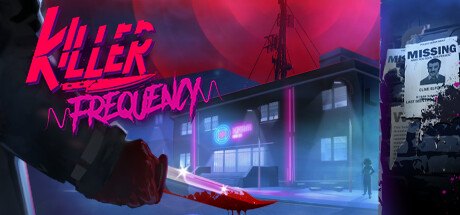

America - Front
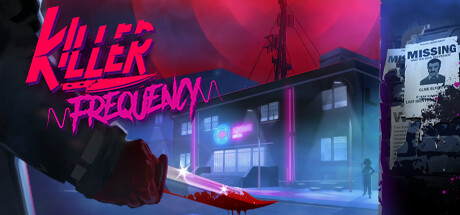

America - Back

Team17 Digital Ltd
Puzzle
 (Add Date)
(Add Date) (Add Date)
(Add Date) (Add Date)
(Add Date)
| Owners: | 0 |
| Favorite: | 0 |
| Tracked: | 0 |
| Wishlist: | 0 |
| Now Playing: | 0 |
Have you ever daydreamed at your job about being swept up in a grander narrative? One moment you're trudging through the doldrums of repetitive paper-pushing or manual labor and then suddenly said job takes on a greater importance, like someone's life is at stake. Team 17 captures that by reconfiguring what's essentially a choose-your-own-adventure story through a crime podcast. While still a mechanically-basic narrative adventure emphasizing dialogue choices, Killer Frequency thoroughly captures your attention through its unique context and inspired theme.
The year is 1987 and there's been a murder in Gallow's Creek, USA. On a seemingly usual school night, former big-shot radio DJ Forest Nash is preparing to broadcast as expected. After an interruptive phone call from the town's sole 911 operator reveals the sheriff has been killed and his deputy knocked out cold, Nash and his producer, Peggy, are foisted into this new role whilst she runs to the nearest city for police backup. Alongside their late-night radio entertainment, the aptly-named "189.16 – The Scream," this duo is now the immediate response crew for the town's latest terror: The Whistling Man. Who wouldn't want to tune in for that?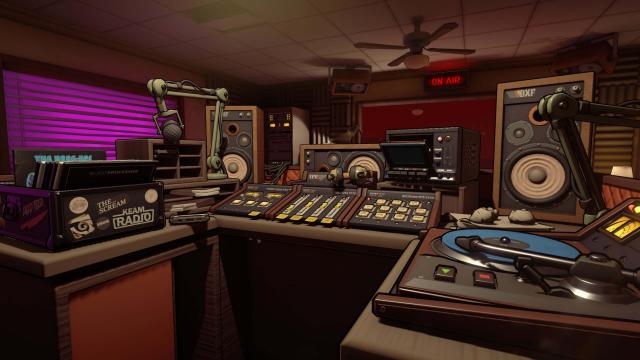
Of course, Forest still has to consider his main role: standing behind the era-appropriate desk taking in any old call, playing a vinyl or advertising cassette, and perhaps fiddling with the soundboard on occasion. But then someone rings 911. The nervous caller needs your help to escape while the killer's trademark whistle echoes in the background. Each scenario requires you to search through different parts of the empty two-story studio to find a particular item that'll save the caller, be it instructions on hotwiring a car, navigating a maze, or something else.
Part of the design's charm is how all the conveniently-placed office clutter leads to each puzzle feeling distinct from the last. Sometimes dialogue choices center around relaying specific instructions, while others subvert expectations by testing your patience or personal judgment. Not all conundrums are created equal, but there's a nice smattering of unique quandaries specific for an analog 80s setting. The pre-internet era demands you rifle through discarded takeout menus to uncover a restaurant's phone number instead of Googling it. Of course, you'll have to forgive some contrivances like certain residents in this Podunk town apparently owning first-era cellular phones, but it's worth glossing over for the compelling situations.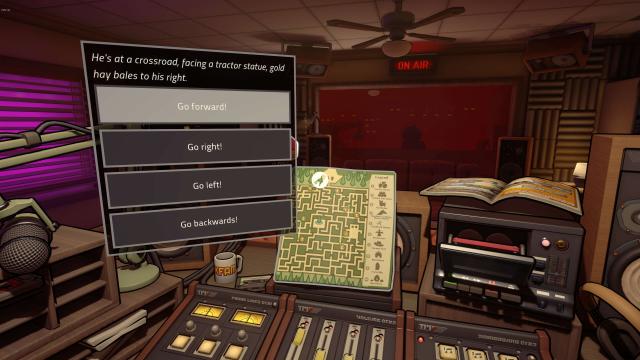
Beyond the off-beat brainteasers, there's also a nice level of superfluous extras that I can't help but appreciate. There's the now-common layer of interactivity where you can sift through shelves, grab random objects, flip through your available records (which always felt satisfying!), and even shoot some wadded paper balls into a basketball hoop during calls. It captures a similar sensation to Gone Home, where you're afforded the opportunity to search through the place, while being a contextually sensible way for Forest to learn about his new town. These qualities are fine distractions, but then there's also playing with the soundboard whenever your heart desires.
There's an interesting dialogue between the 80s slasher aesthetic and the inherent sensationalism of broadcasting life-or-death emergencies on air too. With a soundboard full of diverse options and an optional pun-laden zinger for each character’s death that'd make David Caruso blush, your version of Forest Nash can indulge in shock-jock impulses without serious repercussions. Imagine playing Seinfeld's theme after a victim's throat gets slashed and hearing their last breaths. Even with its apparent ties to cheesy horror flicks, could you allege design immaturity for inviting such opportunities? Well… perhaps there's a fair case to be made. For me, acknowledging the premise's tonal tightrope while enabling players to author Forest towards a more serious or comedic cadence captures that theme more honestly and uniquely.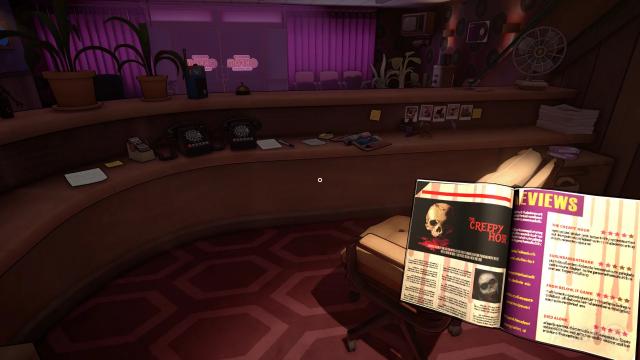
That generous interpretation stems from its sharp writing too. Matt Houghton, John Lappin, Harry Scholefield, and Jack Wilson are able to succinctly capture all of the goods: a genuine sense of place, a town's murderous folk legend, and a successful breadcrumb trail about the potential perpetrator. Just as the game's design mixes on-air dialogue choices with gaps to explore the KFAM building, Frequency's pacing pairs with that as you're uncovering more behind The Whistling Man's potential origins. Sometimes that's done through Peggy's exposition in the sound production stage whilst other times it's from callers or excavating through the environment.
It's by no means perfect, however. Humor and seriousness can be a delicate balance when inspired by such schlocky material, but some comedic portions simply don't land. The recycled trope of a small business owner using air time to sneak in free advertising becomes more and more artificial, especially when Forest and Peggy let him do his spiel after it's so painfully obvious. And just like the ever-so-convenient cell phones for certain callers, a few other contrivances pop up which also second as exposition dumps – though not flagrant by any means. Even with those qualms, Frequency still ranks up there with other prominent walking sims in pacing and intrigue.
Commendable presentation makes it easier to gloss over those specific faults too. One of Team 17's smart economic choices is limiting the amount of character animations on-screen. For a game that opens with a decent jump scare, you'd be forgiven for anticipating something closer to Layers of Fear; in contrast, the person you see most frequently – Peggy – is deliberately obscured behind a tinted window pane. This enables more work to go towards an extra layer of environmental detail, making everything in this… semi-cel-shaded world really pop. Past the aesthetic, the air waves are also filled with solid voice talent, from Josh Cowdery's perfectly-suited DJ voice to several voice actors convincingly inhabiting multiple roles. A solid ensemble of talent, along with Danny Hey and Conor Tissington’s score, that gleefully indulges in 80s horror camp.
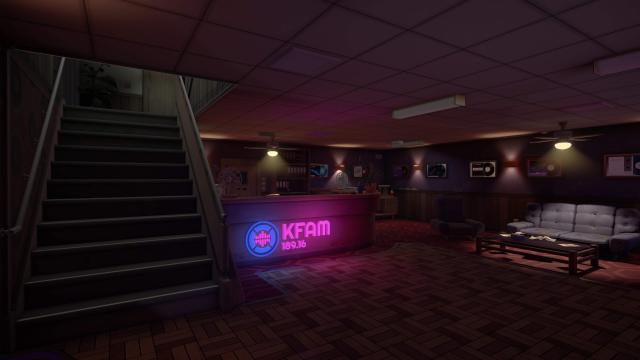
In keeping with a fair few narrative adventures, upfront value can be a dig in its reputation for some people. It's understandable to hesitate throwing 25 greenbacks (retail) for a story-driven experience that clears 4 hours. While the dialogue choices are impactful and there are some minor collectibles that can tempt replays, its focus is more geared towards being a complete story. In that respect, its design ingenuity, creativity, incisiveness, and so on work in concert for a game that's tough to put down. That's where I put the weight of its value.
Like a late-night radio show, Killer Frequency is only as good as its colorful cast and scenarios. Fortunately, it has those in spades. While still falling into the narrative adventure/walking sim phylum, with most of those trappings in tow, Team 17 captures a mechanical nuance that syncs design and story into a hermetically-sealed package. Each individual element – setting, theme, concept, premise, etc. – feels carefully considered for its ultimate goal. There are some era-specific contrivances to make this radio show work, but it's worth the night of neon-drenched murder invading this sleepy town.
Contractor by trade and writer by hobby, Lee's obnoxious criticisms have found a way to be featured across several gaming sites: N4G, VGChartz, Gaming Nexus, DarkStation, and TechRaptor! He started gaming in the mid-90s and has had the privilege in playing many games across a plethora of platforms. Reader warning: each click given to his articles only helps to inflate his Texas-sized ego. Proceed with caution.









